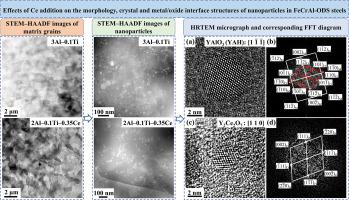添加 Ce 对 FeCrAl-ODS 钢中纳米颗粒的形态、晶体和金属/氧化物界面结构的影响
IF 2.8
2区 工程技术
Q3 MATERIALS SCIENCE, MULTIDISCIPLINARY
引用次数: 0
摘要
铁铬铝氧化物弥散强化(ODS)钢因其优异的宏观性能而成为第四代核反应堆中最有前途的候选包层材料之一。为了满足超临界水冷反应堆(SCPWRs)严格的性能要求,开发了两种 FeCrAl-ODS 钢,即 3Al-0.1Ti (Fe-16Cr-3Al-0.1Ti-0.34Y2O3) 和 2Al-0.1Ti-0.35Ce (Fe-16Cr-2Al-0.1Ti-0.35Ce-0.36Y2O3)。本研究旨在探讨添加 Ce 如何影响 ODS 钢中的微观结构和各种氧化物的形成机制。因此,采用透射电子显微镜(TEM)、扫描透射电子显微镜(STEM)和高分辨率透射电子显微镜(HRTEM)研究了两种 ODS 钢中纳米级氧化物的晶粒和纳米颗粒形态以及晶体和界面结构。3Al-0.1Ti 和 2Al-0.1Ti-0.35Ce 的平均晶粒直径分别为 1.1 μm 和 0.82 μm。与 3Al-0.1Ti 相比,2Al-0.1Ti-0.35Ce 的颗粒平均直径相对较小。结果表明,添加 Ce 可以细化晶粒和纳米级颗粒。对于 3Al-0.1Ti,主要颗粒是 Y-Al-O,比例为 ∼ 81.4 %。对于 2Al-0.1Ti-0.35Ce,主要颗粒是 Y-Ce 和 Y-Ti 氧化物,数量比分别为 52.2 % 和 22.1 %,而 Y-Al 氧化物的数量比仅为 12.3 %。这表明,添加 Ce 可以阻碍 Y-Al-O 的生成,同时促进 Y-Ce-O 的生成。此外,这是首次在添加了 Ce 的 ODS 钇钢中检测到 Y2Ce2O7 氧化物。这项研究的结果为了解氧化物的形成机制、多晶体转变以及因添加铈而产生的微观结构差异提供了重要依据。这将为合金成分的优化提供重要方向,促进 ODS 钢的创新。此外,对两种 ODS 钢的可行性分析表明,它们适用于 SCPWR 燃料包壳。本文章由计算机程序翻译,如有差异,请以英文原文为准。

Effects of Ce addition on the morphology, crystal and metal/oxide interface structures of nanoparticles in FeCrAl-ODS steels
FeCrAl oxide dispersion strengthened (ODS) steel is one of the most promising candidate cladding materials in generation IV nuclear reactors due to its exceptional macro-properties. To address the stringent performance requirements of supercritical water-cooled reactors (SCPWRs), two FeCrAl-ODS steels, i.e., 3Al–0.1Ti (Fe–16Cr–3Al–0.1Ti–0.34Y2O3) and 2Al–0.1Ti–0.35Ce (Fe–16Cr–2Al–0.1Ti–0.35Ce–0.36Y2O3), were developed. This study aims to investigate how Ce addition influences the microstructure and the formation mechanisms of various oxides in ODS steels. Therefore, the grain & nanoparticle morphologies, and crystal & interface structures of nano-scale oxides of the two ODS steels were studied by transmission electron microscopy (TEM), scanning transmission electron microscopy (STEM) and high-resolution transmission electron microscopy (HRTEM). The mean grain diameter of 3Al–0.1Ti and 2Al–0.1Ti–0.35Ce is 1.1 μm and 0.82 μm, respectively. Compared with 3Al–0.1Ti, the average diameter of particles of 2Al–0.1Ti–0.35Ce is relatively smaller. The results indicate that adding Ce can refine the grains and nano-sized particles. For 3Al–0.1Ti, the main particles are Y–Al–O with a proportion of ∼81.4 %. For 2Al–0.1Ti–0.35Ce, the main particles are Y–Ce and Y–Ti oxides with quantity ratios of ∼52.2 % and ∼22.1 %, respectively, while the quantity ratio of Y–Al oxides is only 12.3 %. This indicates that adding Ce can impede the occurrence of Y–Al–O while facilitating the generation of Y–Ce–O. Moreover, it is the first time that Y2Ce2O7 oxide has been detected in yttria-added ODS steels with Ce. The findings obtained from this study provide key insights into the mechanisms of oxide formation & polymorphic transitions, and microstructural differences due to Ce addition. This will provide pivotal direction for the optimization of alloy compositions, promoting the innovation of ODS steels. Additionally, the feasibility analysis of the two ODS steels indicates their applicability to the SCPWR fuel cladding.
求助全文
通过发布文献求助,成功后即可免费获取论文全文。
去求助
来源期刊

Journal of Nuclear Materials
工程技术-材料科学:综合
CiteScore
5.70
自引率
25.80%
发文量
601
审稿时长
63 days
期刊介绍:
The Journal of Nuclear Materials publishes high quality papers in materials research for nuclear applications, primarily fission reactors, fusion reactors, and similar environments including radiation areas of charged particle accelerators. Both original research and critical review papers covering experimental, theoretical, and computational aspects of either fundamental or applied nature are welcome.
The breadth of the field is such that a wide range of processes and properties in the field of materials science and engineering is of interest to the readership, spanning atom-scale processes, microstructures, thermodynamics, mechanical properties, physical properties, and corrosion, for example.
Topics covered by JNM
Fission reactor materials, including fuels, cladding, core structures, pressure vessels, coolant interactions with materials, moderator and control components, fission product behavior.
Materials aspects of the entire fuel cycle.
Materials aspects of the actinides and their compounds.
Performance of nuclear waste materials; materials aspects of the immobilization of wastes.
Fusion reactor materials, including first walls, blankets, insulators and magnets.
Neutron and charged particle radiation effects in materials, including defects, transmutations, microstructures, phase changes and macroscopic properties.
Interaction of plasmas, ion beams, electron beams and electromagnetic radiation with materials relevant to nuclear systems.
 求助内容:
求助内容: 应助结果提醒方式:
应助结果提醒方式:


